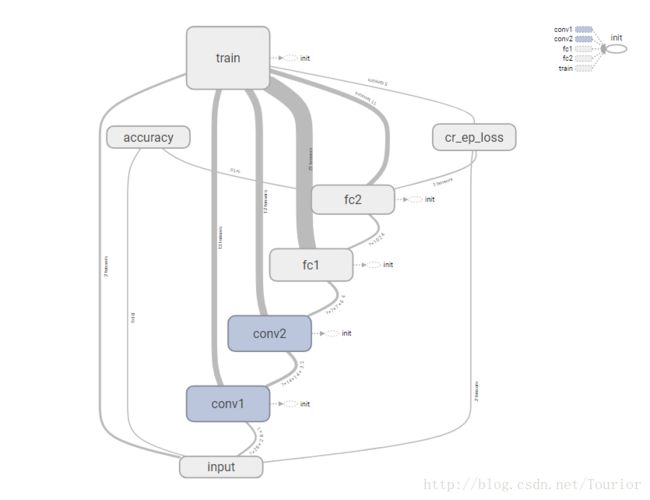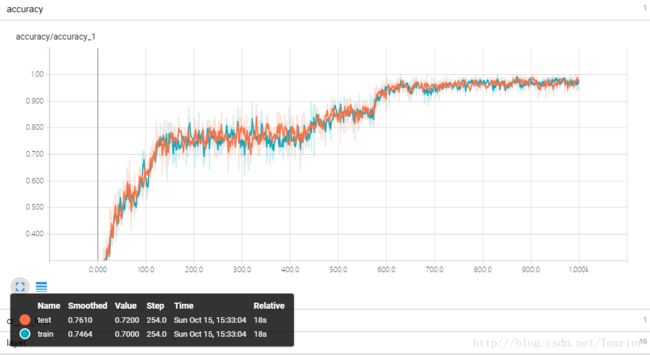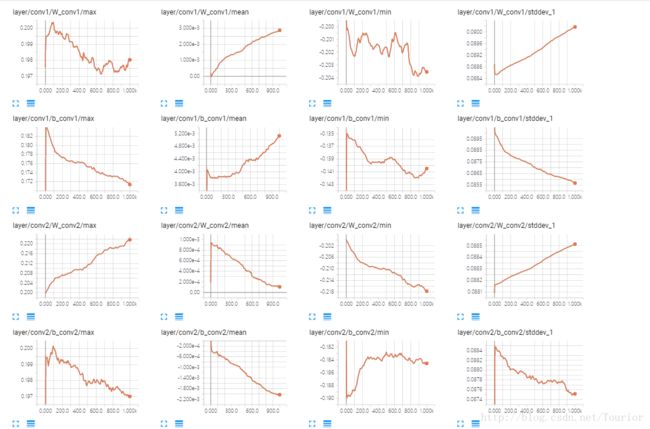Tensorboard 可视化模板例子
Tensorboard 可视化模板例子
#!/usr/bin/env python
# -*- coding: utf-8 -*-
import tensorflow as tf
from tensorflow.examples.tutorials.mnist import input_data
#载入数据
mnist = input_data.read_data_sets('../data/mnist' , one_hot= True)
#每个批次大小
batch_size = 100
n_batch = mnist.train.num_examples // batch_size
#参考概要
def variable_summaries(var , name = 'summaries'):
with tf.name_scope(name):
mean = tf.reduce_mean(var)
tf.summary.scalar('mean', mean) #平均值
with tf.name_scope('stddev'):
stddev = tf.sqrt(tf.reduce_mean(tf.square(var - mean)))
tf.summary.scalar('stddev' , stddev) #标准差
tf.summary.scalar('max' , tf.reduce_max(var)) #最大值
tf.summary.scalar('min' , tf.reduce_min(var)) #最小值
tf.summary.histogram('histogram' , var) #直方图
#初始化权值
def weight_variable(shape):
with tf.name_scope('weight'):
initial = tf.truncated_normal(shape,stddev=0.1) #生成一个截断的正态分布
W = tf.Variable(initial , name='W')
return W
#初始化偏置
def bias_variable(shape):
with tf.name_scope('biases'):
initial = tf.truncated_normal(shape=shape , stddev=0.1)
b = tf.Variable(initial , name='b')
return b
#卷积层
def conv2d(x , W):
with tf.name_scope('conv2d'):
return tf.nn.conv2d(x , W , strides=[1,1,1,1] ,padding='SAME')
def max_pool_2x2(x):
with tf.name_scope('max_pool_2x2'):
return tf.nn.max_pool(x ,ksize=[1,2,2,1] , strides=[1,2,2,1] , padding='SAME')
#定义placeholder
with tf.name_scope('input'):
x = tf.placeholder(tf.float32 , [None , 784] ,name = 'x_input') #28*28
y = tf.placeholder(tf.float32, [None , 10] , name='y_input')
#改变x的格式转为4D的向量[batch , in_height , in_width , in_channels]
x_image = tf.reshape(x , [-1,28,28,1] , name='x_image')
tf.summary.image('input_image', x_image,12)
with tf.name_scope('conv1'):
#初始化第一个卷积层的权值和偏置
W_conv1 = weight_variable([5,5,1,32]) #5*5采样窗口,32个卷积核从一个平面抽取特征
b_conv1 = bias_variable([32]) #每一个卷积核一个偏置
variable_summaries(W_conv1 , 'W_conv1')
variable_summaries(b_conv1, 'b_conv1')
#把x_image和权值向量进行卷积,加上偏置,然后应用relu激活函数,maxpooling
h_conv1 = tf.nn.relu(conv2d(x_image , W_conv1) + b_conv1 , name= 'relu')
h_pool1 = max_pool_2x2(h_conv1)
with tf.name_scope('conv2'):
#初始化第二个卷积成的权值和偏置
W_conv2 = weight_variable([5,5,32,64]) #5*5采样窗口,64个卷积核从32个平面抽取特征
b_conv2 = bias_variable([64]) #每一个卷积核一个偏置
variable_summaries(W_conv2 , 'W_conv2')
variable_summaries(b_conv2, 'b_conv2')
#把h_pool1和权值向量进行卷积,加上偏置,然后应用relu激活函数,maxpooling
h_conv2 = tf.nn.relu(conv2d(h_pool1 , W_conv2) + b_conv2 , name='relu')
h_pool2 = max_pool_2x2(h_conv2)
#28*28的图片第一次卷积后28*28,pool后14*14
#第二次卷积14*14,pool后7*7
#经过上述之后得到64张7*7的平面
with tf.name_scope('fc1'):
#初始化第一个全连接的权值
W_fc1 = weight_variable([7*7*64 , 1024]) #上一层有7*7*64个神经元,全连接层有1024个神经元
b_fc1 = bias_variable([1024])
#将池化层2的输出转换成1维
h_pool2_flat = tf.reshape(h_pool2 , [-1,7*7*64])
#求第一个全连接的输出
h_fc1 = tf.nn.relu(tf.matmul(h_pool2_flat,W_fc1)+ b_fc1)
#dropout
with tf.name_scope('dropout'):
keep_pro = tf.placeholder(tf.float32)
h_fc1_drop = tf.nn.dropout(h_fc1 , keep_pro)
with tf.name_scope('fc2'):
#初始化第二个全连接
W_fc2 = weight_variable([1024,10])
b_fc2 = bias_variable([10])
#计算输出
with tf.name_scope('softmax'):
prediction = tf.nn.softmax(tf.matmul(h_fc1_drop , W_fc2) + b_fc2)
with tf.name_scope('cr_ep_loss'):
#交叉熵代价函数
cross_entropy = tf.reduce_mean(tf.nn.softmax_cross_entropy_with_logits(labels=y,logits=prediction))
tf.summary.scalar('cr_ep_loss' , cross_entropy)
with tf.name_scope('train'):
#使用AdamOptimizer优化
train_step = tf.train.AdamOptimizer(1e-4).minimize(cross_entropy)
with tf.name_scope('accuracy'):
#将结果放进布尔列表
correct_prediction = tf.equal(tf.argmax(prediction , 1) , tf.argmax(y ,1))
accuracy = tf.reduce_mean(tf.cast(correct_prediction , tf.float32) , name='accuracy')
tf.summary.scalar('accuracy',accuracy)
merged = tf.summary.merge_all()
with tf.Session() as sess:
sess.run(tf.global_variables_initializer())
train_writer = tf.summary.FileWriter('logs/train' , sess.graph)
test_writer = tf.summary.FileWriter('logs/test' , sess.graph)
for i in range(1001):
batch_xs , batch_ys = mnist.train.next_batch(batch_size)
sess.run([merged , train_step], feed_dict={x:batch_xs , y:batch_ys , keep_pro:0.7})
train_summary = sess.run(merged , feed_dict={x:batch_xs , y:batch_ys , keep_pro:1})
train_writer.add_summary(train_summary , i)
batch_xs, batch_ys = mnist.test.next_batch(batch_size)
test_summary,acc = sess.run([merged , accuracy] , feed_dict={x:batch_xs , y:batch_ys , keep_pro:1})
test_writer.add_summary(test_summary, i)
if i%100 == 0:
test_acc = sess.run(accuracy, feed_dict={x: mnist.test.images, y: mnist.test.labels, keep_pro: 1.0})
train_acc, loss = sess.run([accuracy,cross_entropy] , feed_dict={x:mnist.train.images[:10000] ,
y:mnist.train.labels[0:10000],
keep_pro :1.0})
print('Iter :%s; loss%s; Train Accuracy:%s; Test Accuracy:%s'%(
str(i) , str(loss),str(train_acc),str(test_acc)))
tensorboard 显示的Graphs
使用with tf.name_scope()定义命名空间
train_writer = tf.summary.FileWriter(‘logs/train’ , sess.graph) 语句写入logs文件
显示loss和accuracy
记录loss
cross_entropy = tf.reduce_mean(tf.nn.softmax_cross_entropy_with_logits(labels=y,logits=prediction))
tf.summary.scalar('cr_ep_loss' , cross_entropy)记录accuracy
batch_xs , batch_ys = mnist.train.next_batch(batch_size)
sess.run([merged , train_step], feed_dict={x:batch_xs , y:batch_ys , keep_pro:0.7})
train_summary = sess.run(merged , feed_dict={x:batch_xs , y:batch_ys , keep_pro:1})
train_writer.add_summary(train_summary , i)
batch_xs, batch_ys = mnist.test.next_batch(batch_size)
test_summary,acc = sess.run([merged , accuracy] , feed_dict={x:batch_xs , y:batch_ys , keep_pro:1})
test_writer.add_summary(test_summary, i)显示权值偏置的统计信息
定义统计函数:
def variable_summaries(var , name = 'summaries'):
with tf.name_scope(name):
mean = tf.reduce_mean(var)
tf.summary.scalar('mean', mean) #平均值
with tf.name_scope('stddev'):
stddev = tf.sqrt(tf.reduce_mean(tf.square(var - mean)))
tf.summary.scalar('stddev' , stddev) #标准差
tf.summary.scalar('max' , tf.reduce_max(var)) #最大值
tf.summary.scalar('min' , tf.reduce_min(var)) #最小值
tf.summary.histogram('histogram' , var) #直方图使用:
传入需统计的变量和命名空间
W_conv1 = weight_variable([5,5,1,32]) #5*5采样窗口,32个卷积核从一个平面抽取特征
b_conv1 = bias_variable([32]) #每一个卷积核一个偏置
variable_summaries(W_conv1 , 'W_conv1')
variable_summaries(b_conv1, 'b_conv1')显示输入图片
记录显示图片
x_image = tf.reshape(x , [-1,28,28,1] , name='x_image')
tf.summary.image('input_image', x_image,12) #12表示在tensorboard中显示12张图片




